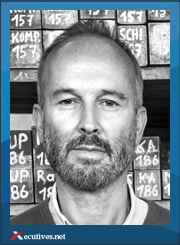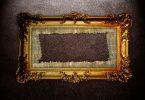Erwin Wurm, born in 1955, is an Austrian artist who has become known worldwide for his sculptural works, including his one-minute sculptures. His art is exhibited in many museums around the world, including MoMA, The Museum of Modern Art in New York, Centre Georges Pompidou in Paris, Tate Modern in London, Museum Ludwig in Cologne and Albertina in Vienna. His art was also exhibited in Switzerland very early on. Under the title Peace & Plenty, 600 drawings by the artist can currently be seen in the Kunstmuseum Luzern. Wurm has received numerous awards for his artistic achievements. In 2013 he received the Grand Austrian State Prize and in 2015 he became Austrian of the Year in the category Cultural Heritage. In exclusive an interview with Xecutives.net, Erwin Wurm provides insights into his artistic work. He elucidates why he likes to work with sculptures, how he reinvents himself and what can be read between the lines in his art. Erwin Wurm describes how he uses realistic objects and forms known to everyone, such as cars, cucumbers or houses, in his artistic work, and presents them from a paradoxical and absurd perspective.
Xecutives.net: Mr Wurm, at the outset of this conversation we were talking about music, including Jon Lord of Deep Purple, and you were surprised that your two sons knew his music. You explained how you keep noticing that younger people know music, but also other things from earlier times. This line of reflection leads me to ask you what makes art immortal. What do you think art must contain, so that in a hundred years time it will still be considered masterworks by later generations in museums? I am also thinking of Johann Sebastian Bach, whose music had been forgotten for over a century and which was rediscovered and made famous rather by chance. Today Bach is undoubtedly an integral part of our musical history.
Erwin Wurm: Good art is always the authentic confrontation with something in a certain time. This is why it is often very easy to determine when a work of art was made, whether in the Seventies, Sixties or Twenties of the last century. However, it is more difficult to define the language of the respective present. In retrospect, this is often easier to achieve. The task of the artist in his respective time is to speak this language as an artist, to express himself authentically in it.
Tastes are constantly changing. You mentioned Bach. There is another very interesting example from painting: something similar happened to Jan Vermeer van Delft. For centuries, this Dutch painter was less appreciated than Pieter de Hooch. The name Pieter de Hooch had been written on paintings by Jan Vermeer van Delft because it was better known and more popular. In Vienna, a picture by Pieter de Hooch hung in the salon of Count Czernin’s family until the 1930s. It was not until its restoration that it was discovered that it was not a de Hooch, but a picture by Jan Vermeer van Delft.
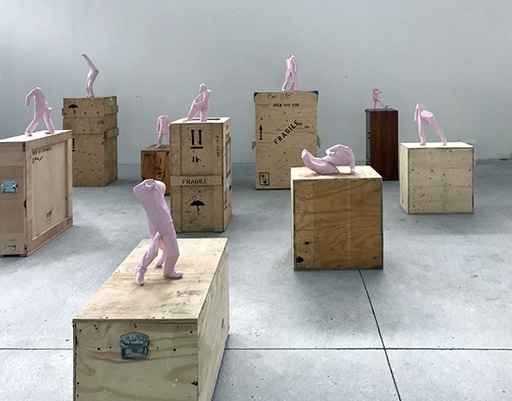
Erwin Wurm (2016) Verschnitt Skulpturen (c) Foto Studio Wurm
Xecutives.net: You have said that an artist should be authentic. What do you mean by „being authentic“?
Erwin Wurm: That’s very difficult to answer. You have to find yourself: „Find yourself, be yourself“. At the beginning of my career I felt the need to measure myself against the great achievements in the world of art. So I had set the bar very high. Only when that was no longer important to me due to a tragic experience in my life, was that all ‘sausage’ to me.
In order to be authentic, you sometimes have to be able to switch off your brain. Authenticity does not necessarily mean to reflexively force authenticity, but it is about letting happen what simply happens. To do this you have to be honest with yourself.
Xecutives.net: Where does this need to want to find oneself and produce art and be artistically active come from? I remember a conversation with Georg Kreisler, a native of Vienna, who later made a career in the USA and then returned to Europe to become a well-known cabaret artist, composer and author. Throughout his life he had dealt with the question of where his inspiration came from, and had reported on it in great detail in his conversations. He even saw something divine in this source of inspiration.
Erwin Wurm: The creative process and creativity are often equated with such ideas. But you can equate that with anything. Ultimately, it is a primary human desire to invent something and create something. People in the Stone Age already did this. I had an early urge to want to draw and to create sculptures. Already as a small child I played with crib figures, so that my parents were afraid that I might become a priest. But I was interested in the figures, the small carved sculptures. I was also interested in paintings. But at home there was no art…
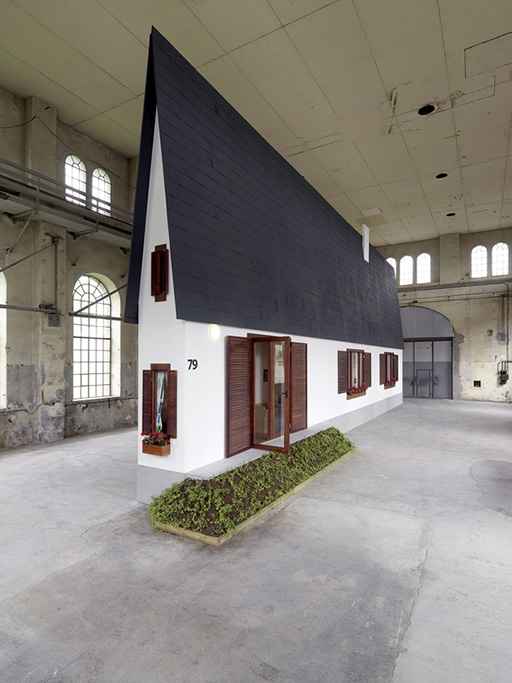
Erwin Wurm (2010) Narrow House, Dornbirn (c) Robert Fessler
Xecutives.net: … the house was also very narrow…
Erwin Wurm: (Laughs) Yes, my father was a detective. I grew up normal and had a happy childhood. But art and philosophy didn’t exist here. That was also completely okay and not necessary for my parents. When I opened the gate in this direction, there was nothing else for me. But where this urge or wish came from, I cannot say.
Initially I grew up in an apartment building. Two other children from this house also became artists. Maybe a comet flew over this house…. (laughs).
Yes, and you are absolutely right about the house. I use realism, and then change things that everyone knows. I try to represent these things from a paradoxical and absurd perspective. You can use it to make other things visible. You are immediately involved with these perspectives. That’s more difficult with abstract art. You have to read into it and empathize with it for a long time before you can understand it. But there are other levels that you have to work your way into. The parental home, which I shrunk, contains such a different level. The house was never meant to be funny. I was interested in the claustrophobic effect and aspect, the emotional narrowness. You feel imprisoned and have to push through the narrow house. Fat people can’t get in at all. The work has to do with the late sixties, when the house was built in the time of the post-war society. The way of thinking at that time was narrow. We were still physically chastened at school. That no longer exists today. But I wanted to express all this with the house. The narrowness and limitation should show how society functioned back then, how I perceived it back then.
I don’t simply approach such projects and think about how I can trigger something in people. There are certain connections in life that concern me. I want to address and point them out. So I made big cars and a big house. These are the most important objects of identification in our society. Through houses and cars we define possession and social belonging. What happens if you make them fat, if you connect them with the biological system of „growth“? Suddenly these objects present themselves differently, they themselves become biological. The car, for example, gets a face.
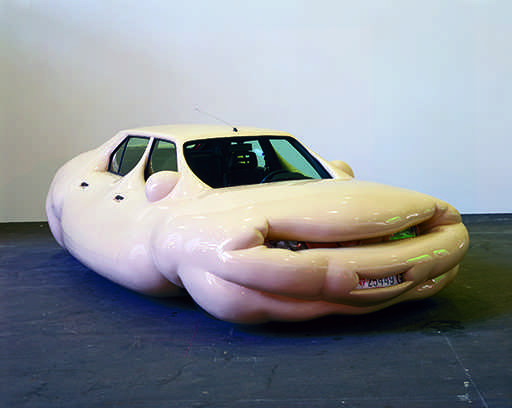
Erwin Wurm (2001) Fat Car (c) VG Bild-Kunst Bonn 2017
Xecutives.net: But you are also making certain people look ridiculous. A circumstance that you are quite aware of.
Erwin Wurm: Yes, sure, with pleasure and love! The cars of the bigwigs in the seventies were called the „fat“ cars. They created the template for my Fat Cars.
Xecutives.net: You could have stayed with these fat objects, thus becoming public, as Georg Kreisler put it, and you would have had a huge commercial success. However, you said in an interview that you had become the „prison officer of your own ideas“.
Erwin Wurm: That’s exactly how it is! When you make art, you don’t think of money, you want to make something that moves you and others. That is the primary thing. The commercial is the last thing on the agenda. Ideational success is important, not financial success. It is about developing new things and moving on. Everyone realizes that if you can do something well, it will eventually be good and sometime very good. But at some point it also gets boring. You have eliminated all mistakes and you can do it now. It’s more exciting when you can work on things anew, try them anew and get involved in new fights.
Xecutives.net: When did the moment come when you consciously realized that you wanted to go this way and put everything on one card? I mean, the decision to become an artist is not easy. It’s also about existential questions. Many people make art, but they can’t make a living from it, or can live from it more badly than right, as in sports.
Erwin Wurm: I started early to buy literature and books with my first pocket money. I read a lot. Then came the artist portraits that interested me. They impressed me very much. Many artists were free and had paid little attention to conventions, which had impressed me very much. I wanted to imitate that. On the one hand there was the art, for example the pictures, which I liked very much. But on the other hand there were the artists and their personal lives. Among them were personalities like Paul Cézanne, Henri Matisse or Pablo Picasso. They were all role models for me. They lived differently from others. They led their own lives, didn’t have to go to the office every day and deal with a boss.
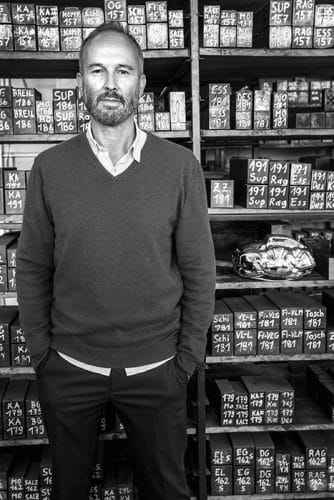
Erwin Wurm, Portrait Wr. Silbermanufaktur, Foto: Inge Prader (2014)
Xecutives.net: But you have also taken considerable risks with this life decision….
Erwin Wurm: Sure, you have to take risks otherwise nothing works. For me, however, they were never burdensome. I had a job for a short time, but then I quit that job when I was 28 years old. I wanted to go my artistic way. At that time I often didn’t know how to pay the next rent, either. But for me that was never a burden and I have pulled it through to this day. I just wanted to do it, had to do it.
When you start out as an artist, you also have ideals. I always wanted to connect with the great achievements of art history and art. Great literature and art inspire me. That has to do with great feelings of happiness. Today, however, I’m more selective than before and much more difficult to deal with and accept other works, but that’s what drives me. I would also like to teach that to my children. But maybe you can’t communicate that at all. It just happened to me. On my mother’s side there were teachers and engineers. On my father’s side there were doctors, but no artists.
Xecutives.net: You explained how art comes out of you. But you also did and completed university studies and thus also dealt with art on an intellectual level. Why did you follow this path? Was that just pure interest in learning more about art and other artists?
Erwin Wurm: That was certainly also an important reason. But it was more about finding like-minded people who were pulling in the same direction. When you are alone, you feel attracted to your peers, to like-minded people and people who pursue the same interests. Already in Graz I was surrounded by such a group of people.
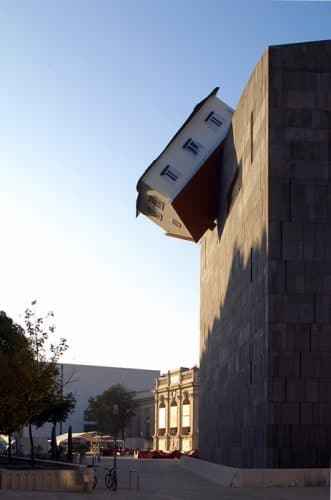
Erwin Wurm (2006) House attack (c) Lisa Rastl
Xecutives.net: So the university in Vienna was a kind of Viennese coffee house where artists meet and exchange ideas, inspire and challenge each other?
Erwin Wurm: Yes, more of a bar than a coffee. It was a great opportunity to meet these like-minded people and to get to know them.
The university is a protected space where you can live out many ideas and try things out. Another possibility would be for these people to join artists and learn directly by working with them. They would get into the art world much faster.
Xecutives.net: Mr. Wurm, you are known for reinventing yourself artistically. I would like to show you a photograph that I noticed in connection with your art. It is the Venus of Wilnsdorf, a figure that is probably over 27’000 years old. Since I have got to know your oeuvre, I can say that this figure reminds me of the Fat Cars series. Venus has been fashioned by her anonymous artist in manner that is luxuriant, small, but somehow also exaggeratedly voluminous: a „Fat Venus“, like your fat cars. This confirms your statement that people since time immemorial have always wanted to express themselves, even artistically. But the figure could also have come from you!
Erwin Wurm: Well, you are talking about a very interesting thing, which I understand a lot about (laughs). The figure is not only 27’000 years (!) old, but much older, namely 41’000 years. Look, these Fat Cars are nothing but an image of the many fat people running around here. This is nothing unusual. But in this figure, the „Fat“ Venus you called, there is much more to it. It’s about sensuality, sexuality, reproduction, the mother, the goddess. It’s about giving birth and reproducing.
Xecutives.net: But it could be a Wurm work….
Erwin Wurm: I really like it. Strangely enough, this work of art is exhibited in the Natural History Museum and not in the Art Museum, which just by the way.
Xecutives.net: The Fat Cars are all funny and funny to look at, but there is also a clear message behind them.
Erwin Wurm: Terms like humor and funny don’t interest me at all. I wasn’t accepted to university when I wanted to study painting. I was put into the sculpture class. I started to deal with the sculptural, which was horrible for me at first. I accepted this challenge, but was frustrated. Sculpture for me consisted of black debris that stood somewhere, shit on by pigeons, not very attractive. But then it was increasingly about the two- and three dimensional, the shell, the mass, the skin, the volume, the movement, the time and the materiality. You have to work it all out slowly. I did that and noticed that when I added clay to a sculpture or took it away, I added or took away volume. I realized that it was nothing else but the biological process of losing weight and gaining weight in humans. I then came to the conclusion that weight gain and weight loss is sculpture.
However, it was also important to me to link the concepts of the sculptural with society, i.e. the world. Is it possible to depict this delusion of weight loss and increase in our society? By this I don’t mean a form of allegory, but the asking of questions. Is it possible to let the concepts of play and work flow into sculpture? Is it possible to elicit sculptural qualities from the terms embarrassment and ridicule? So I started to connect sculptural questions with sculptural principles.
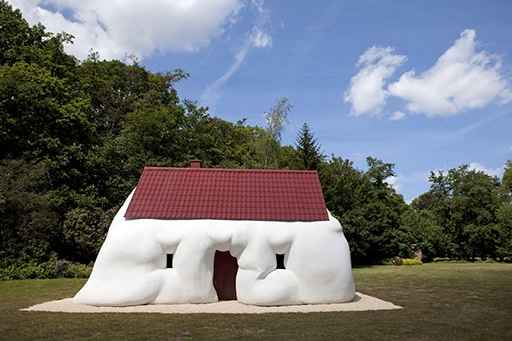
Erwin Wurm (2003) Fat House, Antwerp; Foto: Jesse Willems
Xecutives.net: There is also humour and comedy behind it. My children have to laugh when they look at a fat car like that or when they see their fat house…
Erwin Wurm: I operate with the concepts of realism by immediately recognizing what they are. It is nothing abstract. The absurd is added, as Eugène Ionesco and Samuel Beckett did with words. After all, the paradox plays an important role. If you look at the world from a paradoxical and absurd perspective, you can see more. You can reveal more things that are interesting and ask more questions. But I am not a joke teller. Humour only interested me insofar as it is an interesting means of attracting people to art.
Xecutives.net: But there’s also a good portion of provocation behind and in your art.
Erwin Wurm: Of course, provocation is also part of it. In the example of the sausage sculptures, I didn’t think and don’t think about provocation. I have only tried to make human figures with biologically existing forms. This is a form of abstraction – not like the Cubists. Today I take sausages or cucumbers. They are food and they transport content that interests me.
Xecutives.net: I’d like to come back to the provocation in your art. I am deeply impressed by the idea you recently had. It was about the Heldenplatz, about a project to commemorate the Anschluss of Austria to Hitler’s Germany. Together with Matthias Hartmann and the architect Wolf D. Prix, they wanted to have it sealed off in an artistic action. This project was about the fact that you and your colleagues had thought that if nobody was present in 1938 and no one had cheered on Hitler, there must logically be a place where nobody is standing. I think this idea is excellent and a wonderful form of provocation!
Erwin Wurm: How do you actually know that?
Xecutives.net: You can also find this information on the net. With regard to your idea of the Heldenplatz, I am thinking of the interviews with Georg Kreisler, who had to flee with his family from Vienna to the USA, and of the detailed conversation with Dr. Michael Kogon, the son of Eugen Kogon (author of the book „Der SS Staat“), who had experienced this time in Vienna.
Erwin Wurm: I understand that you see this as provocation. I firmly believe that this serious issue can and should be approached with impertinence, provocation and wit, and not with drama and reverence. I worked with the architect Prix on a similar project, a similar idea, for Germany. It was about an NS school on a mountain in Germany. This former National Socialist school, which could be seen from afar, was to be worked on artistically. The organizers of the project wanted to do something contemporary with it. Our idea was to fill the house completely with concrete, to put a huge banana on top of it, in which there would have been office space. This would undoubtedly have made fun of the building and its purpose at the time. Humour can be very helpful and help to get over wounds and injuries that people like Kreisler and Kogon have suffered and are suffering from. But the project was not accepted.
As far as Heldenplatz is concerned, I am not even aware that the Viennese might have noticed this idea or perceived it as a provocation. This was actually only discussed internally. But it may be that a newspaper reported about it. Unfortunately, such ideas are often not implemented.
But take a look: In Austria we look back on 800 years of monarchy, 700 years of Habsburg, a family that had the country firmly under control. In addition there are 2000 years of the Catholic Church. Between these two power blocks the Austrian soul, the Austrian character, developed. This is already a model for artistic work, also for provocation (laughs).
Xecutives.net: How would you describe this Austrian character today?
Erwin Wurm: It’s all a bit different today. At that time it was certainly the case that behaviour based on the belief in authority prevailed. You had to behave accordingly in the monarchy in order to function. In the end, it was a state of officials and police. Especially under Metternich everything was strictly regulated. Later it all broke down and turned to the right and left, until today.
(The salad is served and there are mosquitoes in the vinegar. E. Wurm draws the attention of the waiter to this and tells the following anecdote from his life, which should not be withheld from the readers here.)
When we react to the mosquitoes in vinegar, I notice that we would have accepted a worm in the tequila bottle (for our english readers: «Wurm» in English is the word for «worm», important to know to get the joke), but not mosquitoes in the vinegar bottle, which leads to the amusement of the staff. (E. Wurm tells the following story.) „I once went to a bar with Fabio Zolly. It was a long time ago. We had ordered tequila. So we stood at the bar, and at some point went „to the house“. Then the bartender asks Zolly: «Do you like the worm?» Zolly said: „Yes“, and zap, there was the worm in his glass!
So much for the excellent Viennese humour…!

Erwin Wurm (2007) Misconceivable, Hotel Daniel, Wien (c) Foto Studio Wurm
Xecutives.net: As a Swiss and Protestant, it all seems a bit strange. Vienna is beautiful, but also weird for me in many ways. I was just in the Sisi Museum and was amazed at its historical process and the many things that happened there, at the crowds in that museum, which were overwhelming, and at the celebration of some soup bowls from which the royal family apparently ate…
Erwin Wurm: Yes, you never had it in the form we have here in Austria. But every country has its own peculiarities. With us, Zwingli and Calvin come to mind in relation to Switzerland. The two types were also quite weird and still have an effect today.
I myself left the church a long time ago. However, the Catholic Church has invented something that is unimaginably ingenious. That is confession. One can confess and the sins are forgiven. That only exists with us! That is unique! With it it lives itself quite well (laughs).
Xecutives.net: You are currently travelling in Switzerland, with drawings in Lucerne and a sculpture in Vevey, where you exhibit your art in a house built by Le Corbusier for his parents, a very small house. What do you have in common with Switzerland?
I have a lot in common with Switzerland. It is neutral, a grassroots democratic country. It seems to do something right. You pay little tax, which is enviable. Our country is in debt. That’s why we pay so much tax. There are also problems with you. You mentioned Switzerland and the Second World War. But somehow politics is capable of solving them.
I have often exhibited in Switzerland and met many great people there. I am very impressed by this Protestant attitude of „create, create Häusle baue“ and at the same time having a culture that is very progressive. There are also many great art collectors among you. Long before I exhibited in Germany, I was already on the road in France and Switzerland, where there was always a lot of interest in my art. I can’t say why exactly that is so. My work was obviously regarded as interesting and worth exhibiting.
My own country is always a bit special in this respect. Maybe that’s the way Swiss artists do it. It’s about the culture of envy, which seems to me to be very pronounced in Austria. I already noticed that at university. If one person had one exhibition more than the other, scenes of envy immediately occurred. But I also hear that from other artists and countries.
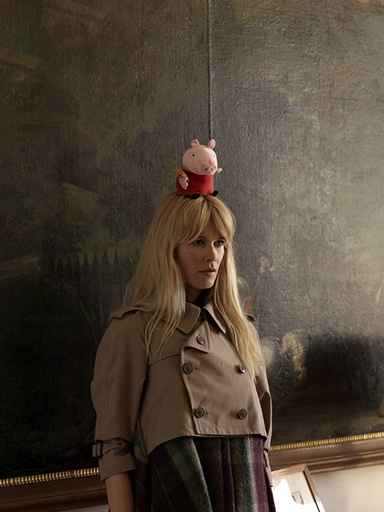
Erwin Wurm (2009) Untitled, Claudia Schiffer, in Vogue 11/2009; Foto: Foto Studio Wurm
Xecutives.net: This Metternich we were talking about was quite a blatant guy. I was just in the Czech Republic in his castle, which I liked very much. At the Vienna Congress, he had once again pulled the emergency brake in favour of the aristocracy and the monarchs, delaying liberal ideas for decades, and that was also an achievement. I mention it because you had had an exhibition together with art by Carl Johann Spitzweg, an artist who dealt with the time after Metternich in his very own way. What was the reason for getting involved with this project?
Erwin Wurm: I underestimated Spitzweg for years. I thought it was a boring Biedermeier painter until I took a closer look at certain pictures. I think of the poor poet in the attic with his Parapluie or of the monk in his tomb who prepares chicken over the fire. Spitzweg did indeed take a political position and made fun of the situation at the time in his own way. I had rejected the project proposal at first, until the curator contacted me again and discussed it with me in more detail. Spitzweg was very rebellious and cynical in his criticism. I found it exciting to bring myself and his art together and have them correspond.
Xecutives.net: You are Austrian and closely connected with Austria and its society and history. What would you call Austrian about your art?
Erwin Wurm: This is a question I am asked again and again. It is difficult to answer. In the country in which you grow up and become socialized, there are many things you take in with your mother’s milk that you don’t even know about that don’t exist anywhere else or are completely different. Austrian cynicism is certainly an important point in my art. I also live in a country where there are great people and great old and new art, a great source of inspiration. Then there are my friends here, many like-minded people and of course my family.
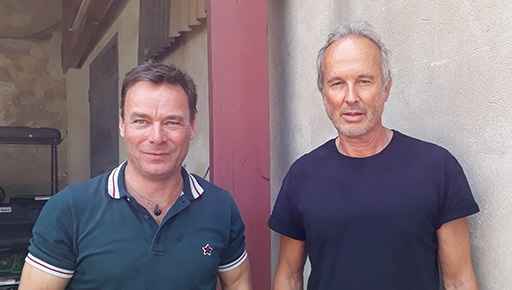
Christian Dueblin & Erwin Wurm
Xecutives.net: What do you wish for Austria?
Erwin Wurm: I wish for the Austrians more relaxation, a correct handling of the past and more serenity in the present. I hope that we will learn more from our mistakes. Germany has achieved a great deal in this respect and worked through a great deal. Austria has also done some of this, but for a long time it has presented itself as a victim state.
We must value our culture and take more care that the people who come to us play by our rules and integrate themselves into our lifestyle. We are too small to withstand an onslaught of people who are organised completely differently.
After all, we have to be critical of our resources. All this requires good politics. Here we still have potential in Austria. And we should not forget that Europe invented the Age of Enlightenment, the basis of our understanding of democracy. We should take care of that, too.
Xecutives.net: Mr. Wurm, thank you very much for the time you have taken for this conversation and the interview and wish you personally, your family and your upcoming art projects all the best!
(C) 2018 by Christian Dueblin. All rights reserved. Other publications are only permitted with the express permission of the author.
The following interviews might also interest you:
- Angela Rosengart über ihre Lieblingsmaler Pablo Picasso und Paul Klee sowie über die Geschichte der Galerie Rosengart in Luzern
- Andrea Raschèr – Provenienzforschung früher und heute mit einem Blick auf die Washingtoner Konferenz 1998
- Prof. Dr. h.c. mult. Reinhold Würth über die Würth-Gruppe, den Zusammenhang zwischen Kunst und Unternehmertum sowie Europas Zukunft
- Bettina Eichin über ihr Leben, ihr Kunstverständnis und ihre Skulpturen
- Kaspar M. Fleischmann über die Anfänge der Fotografie, die Fotografie als Kunstform und seinen Visionen für die Fotokunst
- Ansicht über Impressionismus im Jahr 1883
Links:


